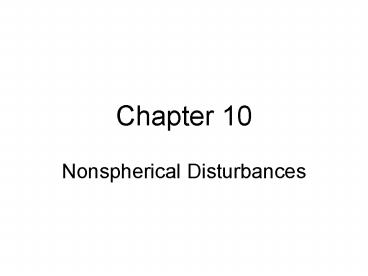Nonspherical Disturbances - PowerPoint PPT Presentation
1 / 21
Title:
Nonspherical Disturbances
Description:
Use OLS or IV (lack of alternatives) Estimate the asymptotic covariance matrix of b (10.3) ... Gauss-Markov theorem is special case where =I ... – PowerPoint PPT presentation
Number of Views:133
Avg rating:3.0/5.0
Title: Nonspherical Disturbances
1
Chapter 10
- Nonspherical Disturbances
2
Overview Part 2
- 10.3 Robust estimation of asymptotic covariance
matrices - Heteroscedastic
- Autocorrelated
- 10.5 Efficient estimation by generalized least
squares estimate (GLS) - GLS
- FGLS
3
Estimation with Nonspherical disturbances
- Discard OLS?
- 3 cases
- ? is completely unknown
- Use OLS or IV (lack of alternatives)
- Estimate the asymptotic covariance matrix of b
(10.3) - ? is known
- Simple and efficient estimate (10.5)
- ? is unknown but its structure is know
- we can estimate ? using sample info (also in
10.5) then tread as if it was known - Often favored over OLS
4
Robust est of asy cov matrices(II)
- Consider the first case ?2? is completely
unknown - If ?2? were known
- Est of asy cov matrix
5
Robust est of asy cov matrices(III)
- Nonlinear LSE
- IV Estimate
6
Robust est of asy cov matrices(IV)
- Let
- Estimate by
- LS b is consistent for ?
- ei point wise consistent for ?i ? i
- ?Use X and e to create an estimator of Q
7
Robust est of asy cov matrices-Heteroscedasticity(
I)
- Heteroscedasticity Case
- Estimated by
- Under very general conditions
- Not an estimate but a function of sample data
close to that of the actual outcomes for large
n!!
8
Robust est of asy cov matrices-Heteroscedasticity(
II)
- By Thrms D2-4 (LLN), if Q has a plim
- consistency of b for ? justifies the replacement
of ei with ?i in S0
9
Robust est of asy cov matrices-Heteroscedasticity(
III)
- Final result White heteroscedasticity consistent
estimator - Especially important if nature of
heteroscedasticity is unknown (most of the time) - Examples in Chapter 11!
10
Robust est of asy cov matrices- Autocorrelation(I)
- Autocorrelation case
- Natural counterpart to White
- Estimate
- With
- But there are a few problems!!
11
Robust est of asy cov matrices-
Autocorrelation(II)
- Problems
- is n-1 times the sum of n2 terms (different
from heteroscedasticity) - needs to be positive definite
- Newey and West came up with an estimator that
solves this problem
12
Robust est of asy cov matrices-
Autocorrelation(III)
- Newely-West autocorrelation consistent covariance
estimator - But how large must L be?
13
Hypothesis Testing
- OLS and IV are asymptotically normal and
asymptotic covariance matrix is estimated - But distribution of the disturbances is not
specified - F-stat is approximate at best
- Likelihood ratio and Lagrange multiplier tests
are unavailable - Wald stat with asymptotic t ratios is main
inference tool - Applications in the next few chapter
14
Efficient estimation by GLS(I)
- Ass ? is known, symmetric, positive definite
- b/c pd it can be factored into
- Let
- Then
- Premultiply the general linear regression model
by P
15
Efficient estimation by GLS(II)
- Transformed GLRM
- y and X are observed data, so CLRM applies to
them! - ?OLS is efficient
16
Efficient estimation by GLS(III)
- generalized least squares(GLS) or Aitken
estimator
17
Efficient estimation by GLS(IV)
- Assume
- the disturbances and regressors are uncorrelated
- the transformed data X is well behaved
- By Aikens theorem GLS is
- Efficient
- Consistent
- Asymptotically normal
- MVLUE
- Gauss-Markov theorem is special case where ?I
- CLRM inference tools can be applied to the
transformed model, but not R2
18
Efficient estimation by GLS(V)
- F-test
19
FGLS(I)
- ? is a n?n matrix containing unknown parameters
- cannot be estimated using the sample
- GLS is not feasable
- Typically there is a small set of parameters
- e.G. time series
20
FGLS(II)
- Let
- Estimate by where
- is asymptotically equivalent to
- use this to obtain the feasible generalized least
squares - Same asymptotic properties as GLS
- But in most cases no finite sample properties!!
21
The End
- Questions?































